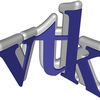The VTK Journal is an Open Access on-line publication covering the domain of scientific visualization.
The unique characteristics of the VTK Journal include:
- Open-access to articles and reviews
- Open peer-review that invites discussion between reviewers and authors
- Support for continuous revision of articles, code, and reviews
